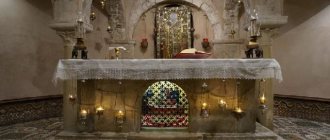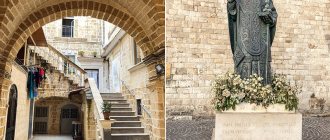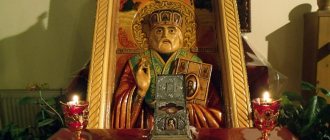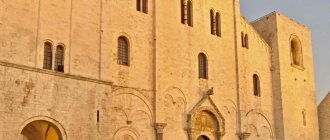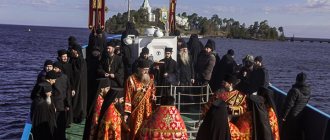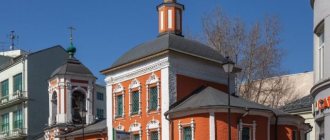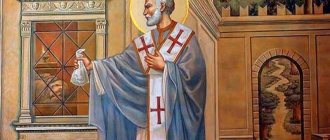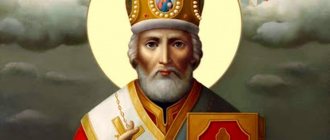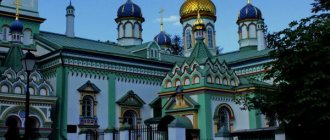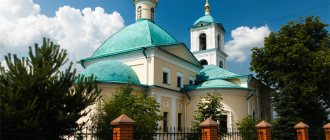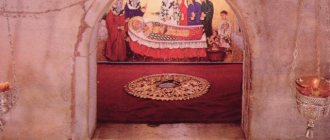Home / Puglia / Nicholas the Wonderworker in Italy in the city of Bari
Many religious travelers visiting Puglia strive to see the Basilica of St. Nicholas the Wonderworker and his relics in the city of Bari.
It is a classical Romanesque basilica in the Apulian style, located in an ancient fortified citadel once occupied by the Catapan court. The Basilica is the main element within the Citadel of Saint Nicholas, which also includes a number of other buildings built over time:
- the Church of San Gregorio, the oldest church in the city;
- monastery;
- the library and archives of the basilica, which contain documents of exceptional historical value;
- The educational center;
- The Portico dei Pellegrini, or Portico of the Pilgrims (today completely missing, lost during restoration work in the 50s), once located in the area where the secondary school “St. Nicholas” is currently located;
- Museum of Saint Nicholas, opened on February 6, 2010, displaying some of the most valuable exhibits from the basilica's archives and treasury
How the relics of St. Nicholas ended up in Bari
The Basilica of St. Nicholas was built in the late 11th century specifically to house the relics of St. Nicholas, brought to Bari on May 9, 1087 from the church of the same name in Myra, Lycia (now in Turkey). In fact, the relics were stolen by Barian sailors. One of the demands of the sailors, before giving away the relics of the Saint, was the construction of a new cathedral to store them.
The local archbishop agreed and gave orders to build a cathedral. As soon as the construction was completed, the relics were placed under the altar of the crypt, where they remain to this day.
Pilgrimage to the relics
Even after his repose, Saint Nicholas does not cease to care for his spiritual children, listening to their prayers and helping the sick and suffering. His prayers especially help children, the elderly, the poor and sick, merchants, sailors and travelers. The saint is revered in all faiths - Orthodox, Catholic, Muslim and even pagans.
Every year thousands of Russian pilgrims come to the city of Bari. Orthodox pilgrims have the right to perform services and prayers, and to contemplate the healing relics of the saint. Many travelers receive divine healing help from the great saint of God. The city of Bari can be proud to have such a shrine as the venerable icon of the saint and his relics.
Construction and restoration
For hundreds of years, strong fortress walls surrounded the Citadel of St. Nicholas. On three sides there were entrance gates from Via Palazzo, the Arch of Anjou and Via Vanese. The basilica itself is surrounded by three squares, which were connected to each other during restoration work carried out in the last century.
These works significantly changed the layout of the premises. Before the construction of the sea promenade in the 1930s, the sea blocked the eastern part of the complex. Thus, the main access to the front square was through the ancient Via Francigena, which today corresponds to the Strada of the Palazzo di Citta. This road was once an ancient route for pilgrims heading to the basilica to commemorate Saint Nicholas, and thus became a meeting point between East and West.
Abbot Ilya ordered the construction of a crypt, which was supposed to shelter the remains of the saint. Work began in 1087 and ended in 1089 with its consecration by Pope Urban II. Construction of the basilica continued during the time of Ilya's successor, Abbot Eustathius. Finally, on June 22, 1197, the Basilica was consecrated.
Until the end of the 19th century, the building was periodically subjected to changes that changed only its original appearance, but not its integrity. However, at the beginning of the 20th century, the season of the “Great Restorations” (1925–1934) was opened, which returned the basilica to its current appearance.
Watch the Easter service at the Basilica in 2022:
Getting to know Bari, or Under the Shadow of St. Nicholas
Ancient city of Bari
Bari is an ancient city. It was once the crossroads of the Mediterranean sea routes. People have settled here since the third millennium BC: Greeks, Romans, Saracens, Byzantines, Normans. The Roman settlement of Barium was first mentioned in 181 BC.
Puglia on the map
Old city
Bari is the main city of the agricultural region of Apulia, which stretches in a narrow strip along the coast of the Adriatic Sea. Puglia is sometimes called the “heel of the Italian boot,” and indeed, if you look at the map, this region looks like the “heel of the boot.”
In terms of population (more than 300,000 people), Bari ranks third in Southern Italy, after Naples and Palermo (the capital of Sicily), but is much safer than both. Immigrants here are only 1%-2% - Albanians, 0.5% - Greeks, the rest of the residents of Bari are native Italians.
Compared to the population of the north and center of Italy, southerners are simpler and more sociable. The atmosphere here is calmer and more relaxed, basically no one is in a hurry, except, perhaps, pilgrims who want to see everything and be on time everywhere. And me, including.
Old and New Bari
Old city
The old part of the city is separated from the new Corso Vittorio Emanuele II by Avenue Victor Emmanuel II (the first king of a united Italy in modern times since 1861). This is a fairly wide and spacious avenue with shady trees, beautiful mansions, many shops and cafes. Here is the oldest theater in the city, built in 1854 and named after the composer Niccolo Piccini, a native of Bari.
But for pilgrims, Old Bari (Bari Vecchia) is of particular interest.
Old Bari is beautiful and mysterious, and its streets keep centuries-old secrets. These cobblestone streets are so narrow and winding that cars cannot drive along them.
The surrounding area is very clean. Every morning, small machines water and clean the white stones of the ancient city. Ancient houses have no entrances or thresholds, and apartment doors simply open onto the street.
Streets of Bari
The English writer, journalist and traveler Henry W. Morton wrote the book “From Rome to Sicily. Walks in Southern Italy" (published in 1969), which Italians themselves recommend to foreigners as a guide to Italy. In the book, Morton wrote about the proximity of Old Bari to New Bari like this: “Like most ancient ports of the Adriatic, the old city is adjacent to the new one. The latter often surpasses the old city in size and is completely different from it. Old Bari is picturesquely located around the cathedral and church of St. Nicholas and the ancient harbor, which served as the departure point for knights on the crusades.
Murat, during his short stay as King of Naples, integrated the new Bari into the old city. Since then, there have been wide avenues lined with palm trees, imposing buildings, excellent shops, one-way traffic, but the usual traffic problems have arisen. I was amazed by the size and vibrancy of Bari.”
Orecchiette
Only a light curtain separates the apartment residents from the street
Almost all year round (with the exception of rare cold days for southern Italy), the doors of the apartments in Old Bari are wide open, and only thin white curtains hide the lives of their inhabitants from passers-by.
However, the Barians are not particularly hiding: the light curtains flutter - and diligent elderly gentlemen flash through the doorways, making at the kitchen tables the famous Apulian pasta in the shape of small ears - orecchiette, for which they use durum wheat flour and water, without adding eggs. On particularly warm days, housewives take tables outside and make orecchiette of all colors and sizes right in front of customers and admiring pilgrims.
All cats stay at home
Holy corner on the street of the Old City
In Old Bari, unlike the New Town, there is stone all around, and neither trees nor shrubs grow - they are replaced by many tubs and pots with fresh flowers. Their colors greatly decorate the stone city. The streets of Bari Vecchia are also distinguished by the complete absence of cats - all cats stay at home.
But there are a lot of dogs, but they are all on leashes. There are not a single stray dog, at least I have not had the chance to meet them. At the end of the trip, I finally saw a lonely dog walking along a deserted street before dawn. The dog waved his tail at me and stopped. He was clearly waiting for someone, and it soon became clear who: the hesitant owner hurriedly ran out from around the corner of the house with a leash in his hands.
Suffice it to mention: “San Nicola”
“Good morning, thank you, please, goodbye” - these words are enough for communication
Many pilgrims worry that they don't speak Italian, and Italians don't speak English well. I had the same anxiety, and I tried to learn a few basic phrases needed by a traveler. After university French and Latin, Italian came easily, and in the meantime I learned a solid vocabulary - but it was not at all useful to me.
Almost every house in the Old City has a holy corner
I had breakfast near the house, in a small cafe, where there was a wonderful smell of freshly brewed coffee, and every morning the owner of the establishment and I greeted each other with the traditional: “Buon Giorno!” Then I asked: “Un caffe e cornetto, per favore!” (coffee and a croissant is a typical Italian breakfast. In the morning, Italians eat very little, but in the evening they have a blast). - “Prago!” (Please!)
And the croissant was still hot, crispy and melted in the mouth, and the cappuccino (Italians traditionally drink it only in the morning) was beyond praise. “Perfetto! Grazie mille!” - I thanked the kind host, and we, very pleased with each other, said goodbye: “Arivederchi!” “Good morning, thank you, please, goodbye” - these words are quite enough for a short trip and brief communication.
I also didn’t need any adverbs of place and time, it was enough to mention: “ San Nicola” - and passers-by began to energetically wave their hands, showing the direction to the Basilica of St. Nicholas, and some even volunteered to lead us.
Under the protection of the great saint of God
In this city it immediately becomes clear - you are under the protection of the great saint of God, Nicholas the Wonderworker
The room I found on the Airbnb website was relatively inexpensive and located in a stone house in the Old Town, a two-minute walk from the Basilica of St. Nicholas. It is noteworthy that the arch leading to the door of the house was called Arco Spirito Santo - the Holy Spirit. Many streets here have pious names.
And in the niches of the walls of almost every house, at every entrance, in every nook and cranny of Bari Vecchia, the eye is attracted by icons with snow-white coverings, figurines of saints, the Blessed Virgin Mary, St. Nicholas, and lit lamps. In this city it immediately becomes clear that you are under the shadow, under the protection of the great saint of God, Nicholas the Wonderworker.
Meet Giuseppe
Street figurines of saints
The house where I rented a room is an apartment building, but the apartments in it are arranged not horizontally, but vertically. So, the apartment of my owner Giuseppe consists of three rooms (each with a separate bathroom) on the first, second and third floors, connected by a very narrow spiral staircase. Giuseppe, or Beppe, rents out rooms on the second and third floors, while he himself lives on the first.
He speaks excellent English, refuting the idea of Italians, and even knows a few words of Russian, having worked for some time in Russia.
Beppe remembers Russian dishes with pleasure: salad, vinaigrette, borscht. He even mentions herring and mackerel - he remembers with what pleasure he savored them with potatoes when visiting the Russians.
But native cuisine is native cuisine.
– We, the inhabitants of Southern Italy, cook very well: we are literally born and raised in the kitchen. We know how to cook correctly and healthy, and the food should be tasty and healthy. Olga, you probably noticed: you walk through the Old Town, and behind every door, behind a curtain that flutters in the wind, there is a kitchen, and this is the center of the whole family. Try sun dried tomatoes! Try burrata and tiella and you will agree with me: Apulian cuisine is the healthiest and most delicious in the world!
And I promise to try.
Beppe is also proud of the antiquity of Bari:
– Can you imagine, Olga, it’s simply impossible to dig here: in every place they find some priceless antiquities! They start digging to lay pipes or cables, and there are solid artifacts: tools, jewelry, dishes - anything for archaeologists!
This is a very safe city!
Beppe is very worried: will I like his hometown?
– Bari is safe! This is a very safe city! Don't be afraid of anything - look, in all apartments the doors are open to the street!
The next day he worries:
- Well, what are your impressions? Did you go out in the evening?
– Yes, I went to St. Nicholas the Wonderworker and read the evening rule and the Psalter in his crypt.
“It was safe to return home, wasn’t it?”
- Yes thank God!
– I told you that Bari is a very safe city!
– True, it bothered me a little when motorcycles rushed past...
- Well, they can’t drive quickly through the Old Town - the streets are too winding... Besides, the noise of a motorcycle can be heard from afar - and you can always step aside...
I actually almost pressed myself against the wall at the sound of the motorcycle and even clutched my bag tightly to me. The most common crimes in Southern Italy are theft and motorcyclists snatching bags from the shoulders of passers-by. In Bari, however, unlike Naples, this practically never happens, but, as they say, God protects those who take care...
I can’t say anything about the new part of the city, but Old Bari is really safe in the evening.
Italians and Russians are very similar
According to Beppe, Italians and Russians are very similar - friendliness, cordiality, hospitality. When Russians invite you to visit, it means that they will greet you as one of their own.
It's just a pity that Russians drink too much. Italians also drink a lot, but they don’t get drunk. Drinking wine is good, generally accepted, good for the stomach. Getting drunk is bad, very bad.
Beppe believes that public opinion is to blame. In Russia, if a person has had too much to drink, they treat him condescendingly, with humor: “It doesn’t happen to anyone!” But if an Italian gets drunk in Bari, public opinion will sharply condemn him. His fellow countrymen will tell him: “What a shame! You've lost face! Go home and never show yourself in public like this again!”
They say we're lazy
Beppe discusses the notorious laziness of Italians as follows:
- They say we are lazy... But this is not true! Once I worked in Germany. We are working and working, and suddenly there is an announcement: a fifteen-minute break! What is it, what's the matter?! It turns out it's hot: the temperature has risen above 30 degrees Celsius, and all employees are entitled to soft drinks at the company's expense and an additional break.
I laughed! If we, in Bari, where the temperature in summer often rises above forty, had such rules, we would not work at all, but only drink soft drinks at the expense of the company!
Both good and bad - at the same time
– Beppe, how would you characterize your compatriots?
- ABOUT! If you stop them on the street and ask for directions, they will be willing to walk a long distance with you just to help! Kind, very friendly people!
But, let’s say, if I’m driving along the road and there’s some kind of conflict, we can swear loudly at each other, even scream! We can be so angry! I don’t know how to answer the question correctly: Barians can be both so good and so bad... And all this at the same time!
– Like all people, Beppe, like all of us...
Italian temperament
As for the temperament of Italians. I had to fly to Bari from another Italian city on a small air plane. The queue for the flight consisted of Italians. And so, when we were already put on the bus that was supposed to take passengers to the plane, things stalled - and we sat in the cold cabin for an hour, after which we were asked to return to the airport building. We returned, stood in the drafty “sleeve” for half an hour, after which we were loaded onto the bus again and taken to the plane, where we waited another hour and a half for takeoff.
It turned out that the flight was already delayed for three hours, and we spent them not in a warm, comfortable airport building, but in rather uncomfortable conditions. Not a single grumbling word, not a single dissatisfied face - complete calm and optimism - that’s what all my companions struck me with. Finally the flight attendant announced the reason for the delay:
“First we had a technical problem, and now we are waiting for people who are late for their flight.
And the latecomers finally showed up. I expected anything: indignation, indignation, but the people around began to laugh good-naturedly and applaud the passengers entering the cabin. To be honest, it was amazing for me.
Whoever did not go to sea did not pray to God
Behind the fortress walls of the Old Town, the Adriatic Sea roars, its azure rivaling the bright blue sky of Puglia and considered one of the cleanest and most transparent seas in the world.
Henry W. Morton wrote: “I know of no more romantic coastline than that of Puglia. Over many hundreds of years, the sun has whitened the local sandstone so that it looks like chalk. Fifty miles in any direction from Bari stretches a series of small seaports and fishing villages, each such village having its own massive Norman castle and a labyrinth of narrow streets... But most of all I remember the dazzling light and, of course, the emerald Adriatic Sea, turning into shade which Homer called “wine-dark.”
Despite the fact that Bari is a port city, the sea here is clean. True, the large, moss-covered boulders on the shore are not particularly conducive to swimming. But pilgrims definitely don’t come here from across the sea...
Bari has an old fishing port and a fish market, and residents of seaside towns always remember: “Whoever has not gone to sea has not prayed to God.” It is not surprising that the image of St. Nicholas the Wonderworker on a boat is in almost every family cafe or tavern - trattoria, osteria, pizzeria.
Bari cuisine
It is traditionally simple, and is based on durum wheat (pasta and bread) and vegetables in combination with fish and seafood. They are not used to soups here; pasta is used instead. A distinctive feature of the kitchen is the homemade abalone pasta (orecchiette), which we have already mentioned. If you buy orecchiette directly on the street, from housewives who will make them in your presence, you need to remember that the ears must be well dried, otherwise they will quickly become moldy.
They say that the peasant roots of Puglia's cuisine are visible on the menu of any establishment. Here, orecchiette is served with turnip salad, or rather, with its tops. Barians also love other garden produce: zucchini, eggplant, legumes.
Olives and olive oil occupy a special place in the Barian diet, which is often taken by the spoonful on an empty stomach for health. Puglia can be proud of its ancient olive groves and the country's first place in oil production.
How to curl an octopus
Among the seafood are octopuses, mussels and, of course, fish. Residents of Bari often eat seafood raw, from shrimp to octopus and sea urchins. Almost everything that is caught in the sea can be eaten raw by the Barian.
Freshly caught octopuses have a jelly-like consistency, they cannot be cut, and fishermen do what is called here “curling or curling an octopus” - they beat the mollusk in a bag against the stones with all their might, right on the shore, or, conversely, hit it with a stone, causing its tentacles to become "curly".
If the octopus is purchased uncooked, it is frozen for several hours in the freezer, and then cut into thin slices and eaten raw, sprinkled with a little olive oil. Sometimes they are boiled and served with olive oil and lemon or stewed, adding tomatoes, peppers, onions, white wine and again (where without it?) olive oil.
Tjella for the Nativity Fast
A common and very ancient peasant dish is tiella: a casserole made from layers of potatoes, rice and vegetables that grew at that moment in the garden (zucchini, tomatoes, etc.), as well as onions, garlic, peppers - in any proportions to your taste. Modern Barians bake whole trays of tiella and, like residents of a seaside town, add mussels.
For Russians, the combination of rice and potatoes is not entirely familiar, but for the Nativity Fast this dish is very suitable even without any mussels. The main thing is that the layers are saturated with juice without mixing, and that you get high-quality olive oil.
Cheeses are the pride of Bari
The cheese here is surprisingly tasty (of course, to try it, you need to come to Bari before or after Lent).
Fresh burrata cheese is a pouch of mozzarella with a creamy center. It doesn’t last long and is literally the cheese of the day: made and eaten the same day.
Other typical Apulian cheeses: surprisingly tender and soft stracciatella (strings of cheese in thick cream) and aged, hard caciocavallo (in the old days it was hung in the barn, two heads at a time, on a crossbar “a cavallo” - “on horseback”).
There is also ricotta, scamorza, canestrato, cachoricotta, pecorino, vacchino and so on, so on, so on, but I didn’t manage to try them: not everything is for Maslenitsa.
Pizzeria
Knowledgeable people advise going to those cafes where locals dine. That’s what I did: I found the most authentic pizzeria in the most secluded place of the Old City. Judging by the conversations, only locals were dining around, and they all ate the same pizza. I ordered the same one. And it was classic Italian pizza.
Barians remain traditional believers and regularly go to temples
I tried it. It was just a thin flatbread with cheese and tomato paste - lots and lots of tomato paste. The pizza was truly delicious thanks to the thin, crispy and at the same time airy dough with a golden crust and a soft, tender core: delicious cheese, tasty and ripe tomatoes. In addition, the pizza turned out to be so big that I could only eat half of it, and finished the rest throughout the day.
The patrons of Bari keep a vigilant eye on their flock
Old Town Bari
Old Bari - Bari Vecchia - is surprisingly clean and beautiful: walls of white and yellow stone, white cathedrals, white robes with hoods of the Dominican monks who take care of the Basilica of St. Nicholas the Wonderworker. In the evenings, when the yellow lanterns are lit, everything around becomes golden: cobbled streets, stone houses, arches.
The charm of Bari Vecchia is amazing: you can walk around this ancient city for hours, just looking at the ancient houses, icons and figurines of saints in niches. You can look under a tiny arch and find yourself in a square, at the door of a majestic cathedral, at a fortress wall, or in a dead end, specially designed to make it difficult for enemies to move around the city and trap them in the event of an attack.
In the temple
Bari Vecchia covers an area of about one square kilometer, but there are more than 30 temples and chapels, all of them active. And in every church there are many common Christian shrines, icons, relics of saints of the first centuries of Christianity: martyrs and saints.
Neither the sea winds blowing from the longest (30 kilometers) promenade in Italy, nor the winds of modern anticlericalism reach here. Barians remain traditional believers and regularly go to churches, and the patrons of the city - Saints Nicholas the Wonderworker and Savin of Kanozsky - keep a vigilant eye on their flock.
Saint Sabinus, Bishop of Canosa
Cathedral of Saint Sabinus, Bishop of Canosa
Almost in the center of Old Bari rises the huge and beautiful Cattedrale di San Sabino - the cathedral of St. Sabinus (Savin), Bishop of Canosa (461–566), built in the 12th-13th centuries.
The Lord was famous for his wisdom and possessed a prophetic gift. For 52 years he served as a bishop and cared for his flock with all zeal and fervent prayer.
Tradition says that in the year 546, the king of the Ostrogoths, Totila, while traveling around southern Italy, was invited to the table by the saint, who at that time was already 85 years old. Totila knew that the bishop was almost blind from old age, and decided to test his insight. Under the guise of a servant, he brought a glass of poison to Saint Sabinus, but the saint meekly thanked the king: “Thank you, Totila.”
In the Cathedral of St. Sabinus
According to another legend, one ambitious archdeacon decided to take advantage of the saint’s blindness and sent a servant to him with a glass full of poison. Saint Sabinus said: “I will drink this poison, but the one who prepared it will not be a bishop in my place.” And indeed, the poison did not harm the saint, according to the word of the Lord: And if they drink anything deadly, it will not harm them (Mark 16:18). The saint remained unharmed, but the archdeacon died at that very moment.
Saint Bishop Sabinus died in the 105th year of his life, on February 9, 566. In the 11th century, the diocesan see was moved from Canosa to Bari , and with it the relics of the saint, which now rest in the crypt.
The great shrine of the cathedral is the Byzantine icon of Hodegetria, the authorship of which is attributed to the Evangelist Luke. The icon was brought to Bari in the 7th century from Byzantium .
And the cathedral itself is located on the piazza (square) Hodegetria.
Saint Colomba of Sanskaya
Saint Colomba
The Rescue of Saint Colomba by a Bear_Giovanni Baronzio
Also in the crypt, in a transparent sarcophagus, in a papier-mâché mannequin, are the relics of
Saint Colomba, or Saint Dove, as the Barians call her.
According to legend, the saint was born in the year 257 in Andorra, into a rich pagan family. At the age of sixteen she converted to Christianity and fled from persecution to France, to the city of Sens. When the saint was found and thrown into prison, the guards decided to take advantage of her defenselessness, but a bear that escaped from the circus (or amphitheater) saved the girl. When they decided to burn the saint at the stake, a dove unexpectedly flew in and the rain began to put out the fire. According to legend, Colomba was executed by beheading with a sword, and one blind townsman, who revered her as a saint, regained his sight after her execution. Saint's Day of Remembrance - December 31st.
Several paintings from the life of Saint Colomba were allegedly painted by the Italian artist Giovanni Baronzio (1326-1362).
Martyrdom of Saint Colomba
Other attractions in Bari
Bari Castle
Not far from the cathedral is the ancient Castello Normanno-Svevo di Bari - the Norman-Swabian castle of Bari, built in the 11th century on the ruins of an earlier Byzantine fortification. The castle served as a fortress, a prison, and a barracks, and has now turned into a museum. It is located on the very edge of the Old Town and is one of the largest defensive structures in all of Puglia. Opening hours: from 8.30 to 19.30 daily (closed on Wednesday).
In Bari you can also see the archaeological museum and the Pinacoteca, the art museum of the province of Bari. Here you can see paintings by Veronese, Tintoretto, Bellini, Giordano, paintings by Corrado Giaquinto, whose name the museum bears, and paintings by contemporary artists. Opening hours: Tue-Sat – from 09.00 to 19.00; Sun – from 09.00 to 13.00. Ticket: € 2.58
The main thing in Bari
Liturgy in the crypt at the relics of St. Nicholas
Bari gained real fame after 1087, when on a sunny May morning three ships of Bari traders returned to their hometown from Myra Lycia with the relics of the great saint - Nicholas the Wonderworker. And, of course, the main thing in Bari is the Basillica di San Nicola, the Basilica of St. Nicholas the Wonderworker.
Liturgy in the crypt
Nicholas the Wonderworker was the most revered saint of that time. Henry W. Morton wrote: “If a ranking were arranged, St. Nicholas would be among the saints in one of the first lines. In England alone, more than 400 churches are dedicated to him, and what can we say about the ancient surnames formed from his name - Nicolet, Nicholson, Nixon and less obvious ones - Cole, Colley, Collis, Colet and Collins. In France, popular female names are Nicolette and Colet.”
Transfer of the relics of the great saint to Bari
In the 11th century, the Turks devastated the Greek lands in Asia Minor, ravaged cities and villages, destroyed holy temples, and desecrated holy relics and icons. They also attempted to destroy the relics of St. Nicholas, deeply revered by the entire Christian world.
Saint Demetrius of Rostov spoke about the history of the discovery of the relics as follows: “In the year 1087, Saint Nicholas appeared in a dream to a certain Christ-loving and righteous presbyter living in Bari and said: “Go and tell the citizens and the entire church council to go to the city of Myra.” , they took me from there and laid me here, because I cannot stay there, in a desolate place. This is the will of the Lord.” Having said this, the saint became invisible. Waking up in the morning, the presbyter told everyone his former vision... Immediately they chose reverent and God-fearing men from among them and sent them in three ships to retrieve the relics of the saint. Posing as if they were going to trade, those men loaded their ships with wheat and set off.”
70 sailors took part in the transfer of the relics, 62 of them were residents of Bari. A year later, in 1088, this event was described by two chroniclers - Nicephorus and John the Archdeacon.
"The Smell of Holiness"
Retelling in part the story of John the Archdeacon, Henry W. Morton wrote: “The greatest triumph for the Venetians was the transfer of the remains of St. Mark from Alexandria. This event occurred in the year 828. Egypt then became a Muslim country, and the saint... in a dream expressed a desire to be “saved” and transported to Christian land.
The situation was similar in Mir, a now destroyed city on the southern coast of Turkey. In 1087, it was captured by the infidels... Having arrived in Mira, the sailors of Bari immediately went to pray at the sanctuary of St. Nicholas, and the Greek monks gave them a small cup with holy liquid - “manna”, poured out from the relics of the saint. This is the first mention of this liquid... Like the Venetians, ... the sailors felt a wonderful aroma, the “smell of holiness.”
John the Archdeacon says that “a subtle aroma wafted across those present.” Meanwhile, a young man named Matvey... put his hand into the sarcophagus and discovered that it was half filled with sacred liquid. “Then he put his right hand into it and, groping for a priceless treasure... began to fearlessly remove it... When he came out, sacred liquid was dripping from his body... The relic was wrapped in new white cloth and placed in a wooden vessel, like a wine barrel.”
Basilica of St. Nicholas
Just two months after the transfer of the relics to Bari, in early July 1087, the residents of the city, under the leadership of the abbot of the Benedictine monastic order Elijah, began construction of a wonderful basilica, which to this day has remained one of the best examples of the Romanesque style in Europe.
The basilica consists of two parts: the upper and lower - the crypt (underground church), where the relics of the great saint of God rest, to whom thousands of pilgrims come to worship.
In 1156, King William I the Evil of Sicily completely destroyed the city for the disobedience of its citizens, but even he did not dare to touch the basilica of the great saint that was being built. The crypt was built and consecrated first, but the construction of the upper part lasted a whole century and ended only in 1197 with the consecration of the temple.
Saint Nicholas
Upon entering the basilica, you immediately see behind the glass a life-size statue of St. Nicholas, created in 1794. It is this statue that on May 8 is taken by ship to the sea (about 150 m from the shore), where it is greeted by numerous pilgrims on boats, and then solemnly carried through the streets of the city. Processions and folk festivities accompany the holiday. On the evening of May 9, in the presence of a large number of believers, the ministers of the basilica (Dominican monks who have been entrusted with this ministry since 1951) open the shrine with the relics of St. Nicholas to collect the miraculous world.
Currently, only two or three glasses of Holy Myrrh or Holy Manna accumulate in the tomb per year, which is added to the blessed water. Small bottles of myrrh can be purchased in the church shop next to the basilica.
In 1359, the miraculous column was first mentioned, which is now located in the right corner of the crypt. According to legend, Saint Nicholas himself, with the help of two angels, placed this column there on the evening before the consecration of the crypt.
Church shop, museum, Arch of Anjou
Vessels for Peace
Dominican monks
On the right side of the basilica there is a sculptural image of St. Nicholas - the work of sculptor Zurab Tsereteli, donated to Bari by President Vladimir Putin.
On the left side of the basilica there is a church shop where you can buy myrrh, icons, books, candles and guides to Bari and Puglia.
Also on the right side of the basilica, just behind it, is the city museum of St. Nicholas, opened in 2010 (ticket € 3, there is a Russian audio guide).
Here you can see beautiful ancient vessels for the holy chrism with scenes from the life of the saint depicted on them, ancient manuscripts, coats of arms, cups made of precious metals, vestments, paintings, rare archival documents, lamps, Russian and Greek icons, chalices, votive gifts, reliquaries and other shrines.
Columns in the crypt
The Arco Angioino,
a magnificent arch from the Angevin period, separates the square with the basilica from the Old Town. Tradition says that everyone who passes under the vault of the arch, crowned with a high relief of St. Nicholas, will receive the patronage of the great saint (high relief is a high relief when the figure protrudes above the plane by more than half of its volume).
Confession in the crypt
Service Schedule
Orthodox services in the crypt are performed as follows:
Monday, Tuesday, Wednesday and Friday at 10.30 – prayer service with reading of the akathist to St. Nicholas the Wonderworker;
Every Thursday at 10-30 – liturgy in Russian (from June 1 to October 15 on Tuesdays and Thursdays);
On Saturdays at 10.30 – prayer service and memorial service;
On Sundays there is liturgy at the Russian Compound of St. Nicholas.
Kindergarten at the Russian Compound
Refectory courtyard
Archpriest Andrei Boytsov in his office in the courtyard
Russian Compound
The only Orthodox cathedral in Bari is located at the Russian Compound
The only Orthodox cathedral in Bari is located at the Russian Metochion of St. Nicholas, built at the beginning of the 20th century especially for Russian pilgrims. Official website of the courtyard: https://bargrad.com/ Pilgrims can stay at the courtyard. Information on the cost of living here: https://bargrad.com/bari-dom-palomnika/
We will tell you about the conversation with the rector of the metochion, Archpriest Andrei Boytsov, in the second part of the article.
Holy Hierarch Father Nicholas, pray to God for us!
Architecture
The Cathedral of St. Nicholas the Wonderworker is built of limestone. Moreover, some of the stones were taken from other buildings. Two low, massive towers flank the main facade: Torre del Catapano (Tower of Catapana) on the right and Torre della Milizia (Tower of the Militia) on the left. The external facade has three parts, distinguished by protruding pilasters, and three portals reflect the internal division into three naves. The central portal is the largest of the three and is endowed with strong symbolism - the image of Christ's victory over the darkness of paganism. The famous Lviv portal is located on the north side of the building.
The interior of the church has the shape of a Latin cross. A beautiful wooden ceiling, decorated with paintings by Carlo Rosa from Bitonto, covers the central nave. The high altar is located at the end of the central nave and is surmounted by the oldest canopy in Apulia (12th century).
Basilica of Bari
The crypt or underground church, located under the transverse nave of the basilica, was built earlier than other parts of the temple. The cross vault is supported by 26 columns, two of which are made of Numidian marble, two of coral chips, one of red marble, and the rest of Greek marble.
How to get there in 2022
The basilica is located in the Italian region of Apulia, or more precisely in its capital - Bari.
Find out how to get to Puglia
Basilica address: Largo Abate Elia, 13, 70122 Bari BA, Italy
AMTAB A bus routes stop near Largo Abate Elia (stop area Piazza Massari).
From Bari train station you can reach it on foot, heading towards Piazza San Nicola.
Along the embankment, if you arrive in the port of Bari, go in the direction: Porto - Arco San Nicola - Largo Urbano II - Piazza San Nicola.
Useful sites:
https://bargrad.com - site of the courtyard
https://www.basilicasannicola.it - Basilica website
Basilica of San Nicola on Lido Island
Relics of St. Nicholas are in the basilica of the 9th century in the shrine above the throne. In addition to the relics of the saint, the relics of the Hieromartyr Fyodor and St. Nicholas, called “uncle,” are buried here. The Venetians took all these relics from Myra Lycia at the same time.
Unlike the Basilica of St. Nicholas in Bari there is no mass pilgrimage to the island of Lido. The Church of San Nicola is visited by single tourists, and the opening hours are quite limited, so the caretaker’s phone number is posted at the entrance, just in case.
Opening hours
Basilica opening hours: Monday to Saturday 8:00 – 12:00, 15:00 – 18:00
How to get there: from Piazza San Marco to Lido SME take vaporetto no. 1 and others, travel time is 15 minutes.
Address: Riviera S. Nicolò, 26, 30126 Venezia VE
Veneration of St. Nicholas of Myra in Rus'
In Rus', the veneration of saints begins no later than the 11th century. Already in Kievan Rus the round image of St. Nicholas the Wet was revered. A little later, the name Nikolai appears in the princely dynasty as the second baptismal name.
Since the beginning of the 12th century, veneration has spread in Novgorod, which is associated with the construction of the St. Nicholas Cathedral around which bargaining arose. So Nicholas the Wonderworker becomes the patron saint of traders and merchants, being already the patron saint of travelers and sailors.
St. Nicholas churches are widespread in Rus', perhaps not without the participation of the Normans, who ruled in the south of Italy in the 11th-12th centuries.
The first temple after the Mongol invasion was built in Nikolsky, Nikola on Lipna.
Over the centuries, local cults have appeared associated with local miracles that were attributed to Nicholas the Wonderworker, legends, local images of Nicholas, for example: Nicholas of Mozhaisky.
In the end, Nicholas becomes a Russian saint, having lost his Greek image, but this is already the realm of folk culture.
The Day of Remembrance of St. Nicholas the Wonderworker, which is celebrated in winter (December 19), is called the Day of St. Nicholas the Winter. This “winter” image of the saint depicts him with a miter, the headdress of a priest, on his head.
Who is Nicholas the Wonderworker
The first information about Bishop Nicholas of Myra began to spread at the end of the 5th - beginning of the 6th centuries. Acts of St. Nicholas were recorded in Myra Lycian in the south of Asia Minor and quickly spread throughout Byzantium.
Since the 9th century, the first life of St. Nicholas of Myra with mention of such facts from life as refusal of inheritance, helping the poor, saving girls from debauchery. Further, miracles with sailors, a miracle with the election to a bishopric, a miracle with imperial grain, and so on.
The Life was written in the style of high rhetoric for an educated public, rewritten, distributed and expanded. Later it was discovered that the life of St. Nicholas of Myra is a mixture of information about two separate individuals.
The fact is that in the 6th century there lived another Nicholas of Pinarsky or Zionsky. He founded a monastery in honor of Saint Zion. He also came from a poor family and helped the poor and needy. The life of this saint has been well studied and known.
It so happened that there were white spots in the life of St. Nicholas of Myra were filled with scenes from the life of St. Nikolai Pinarkiy and so their biographies are mixed.
Be that as it may, by the tenth century the clergy had revised the life of St. Nicholas of Myra into a single text, sanctified it and became the basis for painting icons.
In the 19th century, the Byzantine scholar, head of the Russian spiritual mission in Jerusalem, Archimandrite Antonin Kapustin, saw inconsistencies in the sequence of historical events in the life of the saint. He discovered the second Nicholas - Zionsky and unraveled the whole mystery.
Icons of St. Nicholas from Bari
What do St. Nicholas and Santa Claus
The history of the veneration of St. Nicholas is very diverse. The saint's feast day was celebrated in December. On this day, children were given gifts on behalf of the saint, and bakers, whose patron was St. Nikolai, they distributed baked goods to the poor and sick.
In the West, Nicholas the Wonderworker was often depicted with three bags, as an association with the three bags that the saint threw to the bankrupt rich man to save his daughters from fornication.
However, during the Reformation, the veneration of saints was temporarily stopped, and the tradition of giving gifts was delegated to the infant Christ. Gifts have already been given for Christmas.
But again a miracle happened and St. Nicholas firmly entered the lives of Europeans, and the Dutch, who set off to conquer North America, took away their love for St. Nicholas with you. In their language, the name of the saint sounds like Sinterklaas, but the more euphonious Santa Claus has taken root. There he looks like a kind old man who gives gifts at Christmas, brought in bags or socks.
Description
The temple is a wonderful example of Romanesque Apulian architecture. A massive and impregnable structure with a strong Norman character, it is part of the “Cittadella Nicolaiana”, a complex of buildings erected over time on the territory that once belonged to the Catepan Palace. Today the complex includes:
- the Church of St. Gregory, which is one of the oldest in Bari;
- monastery;
- church archive and library, storing the most important documents, manuscripts and publications of exceptional historical interest;
- Nikolaev Research Center;
- Portico dei Pellegrini;
- The museum opened on February 6, 2010, where you can see the most valuable religious exhibits and documents.
For many hundreds of years, the complex of buildings of the Nikolaev Citadel was surrounded by fortress walls for security reasons and was used more than once as a defensive structure.
The main part of the decoration of the Basilica of St. Nicholas, including architectural, dates back to the period 1090-1125. However, in the structure of the temple one can see reliefs, capitals and other elements of sculptural decoration dating back to an earlier period. Despite the diversity and complexity of the architectural concept, the compositional unity is still obvious.
The façade of the basilica is divided into three parts by pilasters. The main entrance portal is decorated with carvings and crowned with the figure of a winged sphinx.
